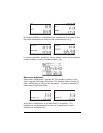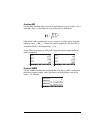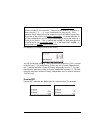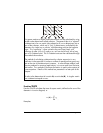
Page 11-9
Functions RNRM and CNRM
Function RNRM returns the Row NoRM of a matrix, while function CNRM
returns the Column NoRM of a matrix. Examples,
Singular value decomposition
To understand the operation of Function SNRM, we need to introduce the
concept of matrix decomposition. Basically, matrix decomposition involves the
determination of two or more matrices that, when multiplied in a certain order
(and, perhaps, with some matrix inversion or transposition thrown in), produce
the original matrix. The Singular Value Decomposition (SVD) is such that a
rectangular matrix A
m×n
is written as A
m×n
= U
m×m
⋅S
m×n
⋅V
T
n×n
,
where U and V are orthogonal matrices, and S is a diagonal matrix. The
diagonal elements of S are called the singular values
of A and are usually
ordered so that s
i
≥ s
i+1
, for i = 1, 2, …, n-1. The columns [u
j
] of U and [v
j
] of
V are the corresponding singular vectors. (Orthogonal matrices
are such that
U⋅ U
T
= I. A diagonal matrix has non-zero elements only along its main
diagonal).
The rank of a matrix can be determined from its SVD by counting the number of
non-singular values. Examples of SVD will be presented in a subsequent
section.
Row norm and column norm of a matrix
The row norm of a matrix is calculated by taking the sums of the absolute values
of all elements in each row, and then, selecting the maximum of these sums.
The column norm of a matrix is calculated by taking the sums of the absolute
values of all elements in each column, and then, selecting the maximum of these
sums.


















